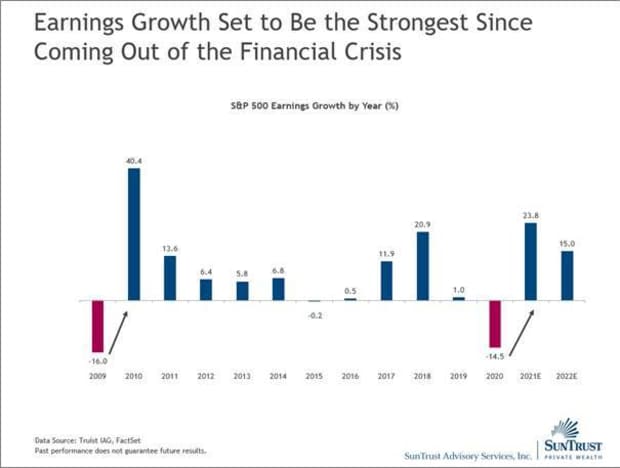Is the stock market due for a correction in 2021? Here’s what some experts think
A pullback for the Dow Jones Industrial Average and the S&P 500 index on Tuesday halted the longest win streak for stocks in months, but a major concern for investors remains: Is there a major correction looming ahead?
Even some bullish investors have called for a retrenchment in stocks as a sort of catharsis for the next leg higher and an unwind of some of the frenzied, retail-inspired betting that has repeatedly sent stocks to fresh records amid the COVID-19 recovery.
A brief pullback that began in late January, tied to the trading fervor around GameStop Corp. GME,
The Dow Jones Industrial Average DJIA,
The year-to-date gains in the large-cap Nasdaq, up 8.7%, and the Russell 2000, up 16.4%, reflect an odd convergence of investor bets: Those wagering on further prosperity in COVID-tested, large-capitalization growth stocks that worked in the aftermath of the pandemic in the U.S. back in March, alongside bets for a sizable rebound in small-cap, economically sensitive stocks represented in the Russell.
In either case, cautious investors and those worried that the good times can’t last forever are bracing for the next major slump for stocks, and ruminating on how it might play out.
Earlier this week, Morgan Stanley’s Michael Wilson told CNBC during an interview that “It was brief, so if you blinked you missed it,” referring to the pullback in stocks in late January.
“That looks like that was it for now, and I mean, the markets are quite powerful at the moment, and they have been,” Wilson said.
“There’s tremendous liquidity, there’s a very good and very understandable story behind the scenes. Meaning, we’ve got a strong economic recovery that’s visible to everyone. The earnings season’s been good so far…and people have bought into it,” the Morgan Stanley analyst said.
He cautioned, however, that the market remains in a “a bit of a fragile state,” and warned that leverage swirling in the system could make pullbacks of 3% or 5% more of the norm.
Wilson did say, however, that the re-emergence of individual investors in financial markets would be a force to be reckoned with, and that they currently represent the marginal buyer on Wall Street keeping asset prices buoyant.
Keith Lerner, chief market strategist at Truist Advisory Services, said that concerns of a stock bubble are overdone and not supported by the current batch of fourth-quarter earnings results, which his firm estimates will be the best since the 2008 financial crisis.

“Although there are frothy segments of the market that are detached from fundamentals, we do not see bubble conditions more broadly,” Lerner wrote in a research report dated Tuesday.
“Instead, we see a stock market that is trading at a premium to historical valuations—partly justified by low rates, a shift in sector composition toward higher-valued growth sectors, supportive monetary and fiscal policy, as well as cheaper access to markets (i.e., secular decline in commissions and fund fees),” the Truist analysts added, noting that a lower barrier to entry for individual investors also was providing support for stock values.
Meanwhile, Daniel Pinto, a co-president at JPMorgan Chase & Co., told CNBC in a Q&A that he expects the stock market to grind higher.
“I think the market will gradually grind up during the year,” he told the news network. “I don’t see a correction anytime soon, unless the situation changes dramatically,” he said, describing possible downturns as mini corrections that won’t necessarily change the overall bullish trend.
What could change things?
Naeem Aslam, chief market analyst at AvaTrade, in a Tuesday report said that optimism in the U.S. market is driven by three actors: Support from monetary and fiscal policy, progress in COVID vaccinations and the solid quarterly results.
“Basically, it seems like the stars are getting in line, and there are strong odds stacked in favour of another bull rally,” Aslam wrote.
“In other words, we need something major changing in the current catalyst to shift the market narrative among traders that can trigger a minor pullback—let alone a serious correction,” he added.
MarketWatch’s William Watts writes that some experts are pointing to the 2009 stock market as the closest parallel to the current setup for equities. Quoting Tony Dwyer, chief market strategist at Canaccord Genuity, Watts noted that 2021 could play out more like the postcrisis scenario seen in 2010, which would point the way to a “solid year” for the market, but with a bumpy ride thanks to “multiple first-half corrections.”
Some of the bumpiness might emanate from the bond market, with the 10-year TMUBMUSD10Y,
The so-called reflation trade, where yields rise and investors gravitate to investments that might prosper in better economic times, has provided a number of false dawns for investors so far.




